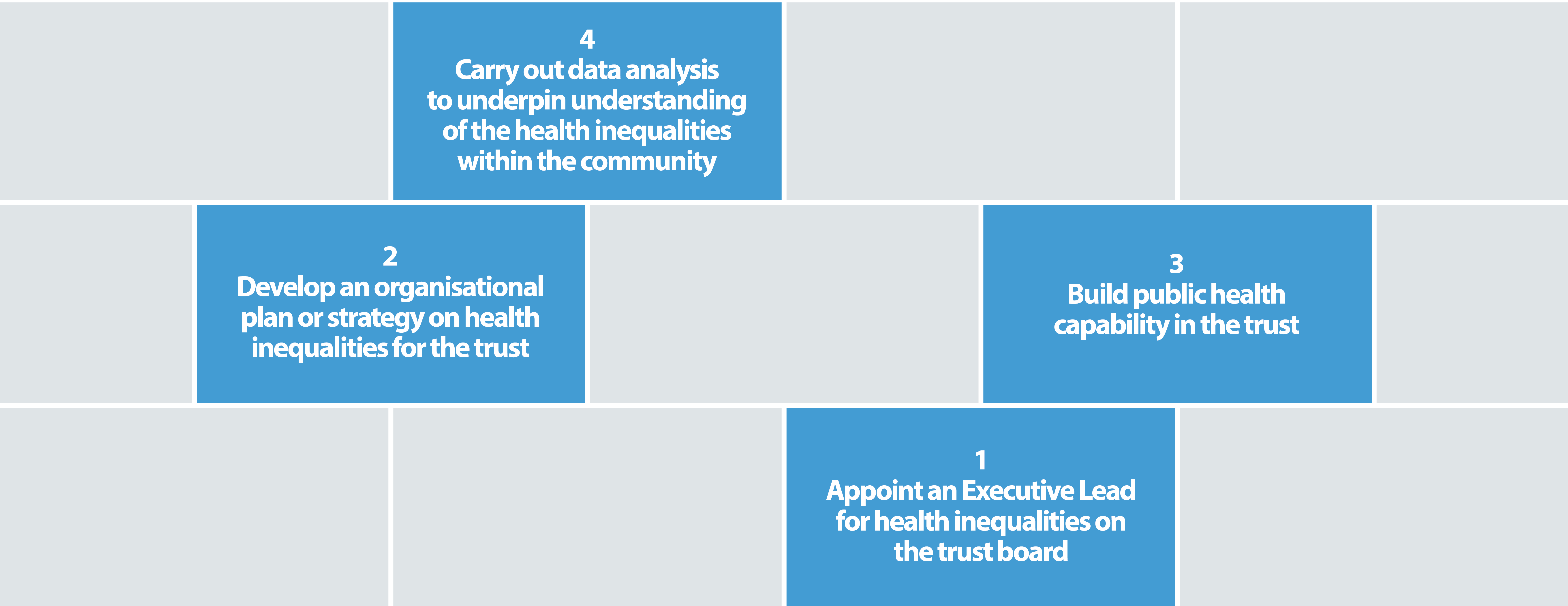This section outlines how trust boards should use the self-assessment tool and objectives in the guide to inform their work on health inequalities. The frequently asked questions section provides more detail on areas not covered here.
Self-assessment tool
We recognise that trusts are all at different stages of their work on health inequalities and selection of objectives within this guide will depend on levels of progress and maturity.
We recommend that trusts complete the self-assessment tool, which has been externally developed to use alongside the guide. The tool contains 25 questions across four domains:
- Building public health capacity and capability
- Data, insight, evidence and evaluation
- Strategic leadership and accountability
- System partnerships
The tool will provide a score and maturity rating of the trust’s position in each of these domains. The different levels of maturity are:
- not started
- emerging
- developing
- maturing
- thriving
Based on the question responses, and current level of maturity, a bespoke set of health inequalities objectives will be suggested within the self-assessment tool. The tool generates a report with question responses, scores and objectives which can be downloaded as a PDF for future reference.
What to do with your results
We recommend using the self-assessment report as a starting point for a board level discussion. The objectives are intended to be broad, rather than prescriptive, and the list of suggested objectives is not intended to be exhaustive. Trusts may wish to select additional and/or different objectives from the full list of objectives. Trusts may also consider adapting the objectives to ensure they are relevant to their local context and setting.
Trusts could consider translating the objectives into SMART actions to support effective delivery (specific, measurable, achievable, relevant, and time-bound). Board members should identify who is best suited to take forward each chosen objective, which could be used in the annual objective setting cycle. Board members are encouraged to set appropriate objectives for their reports to help cascade this work through their organisation.
Reviewing and reporting progress
The self-assessment exercise could be repeated annually, to provide trusts with a mechanism for benchmarking progress over time. The format of the self-assessment tool and objectives could be used as a template for consistent board reporting on health inequalities and trusts may choose to include the self-assessment results as part of their annual health inequalities reporting. The guide should be viewed as a long-term tool for trusts, acknowledging that different objectives will be implemented at different stages, depending on the progressing level of maturity of the trust.
Priority objectives
The key building blocks for trusts starting work on health inequalities relate to strategic direction, action planning, understanding the needs of patients and local populations, and embedding public health capability within the trust’s workforce. We have recommended key areas for action for all trusts to consider:
- Appointing a board level executive lead for health inequalities is a requirement from NHSE (NHS England, 2021a) and therefore should be the first step for all trusts to ensure leadership and accountability (Objective 3.4).
- Develop an organisational plan or strategy on health inequalities for the trust (Objective 6.1).
- Build public health capability in the trust (Objectives 3.5 and 4.7).
- Carry out data analysis to underpin understanding of the health inequalities within the communities the trust serves (Objectives 3.9 and 9.3).
